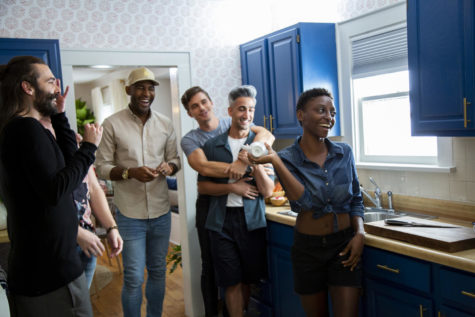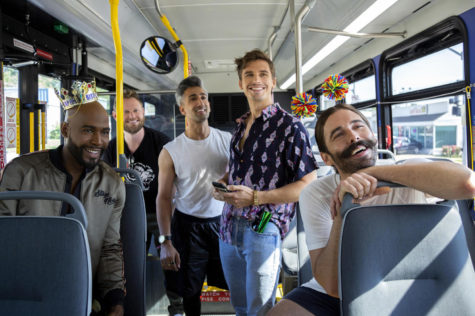Queer Eye is a Real Eye Catcher
Season three of “Queer Eye” brought the Fab Five to KC and leaves a great lasting impression despite the occasional Midwest stereotype.
Even for those who have never seen “Queer Eye” before, season three is exciting because it is set right here in Kansas City. The “Fab Five” travel around the greater Kansas City area and help people in both Kansas and Missouri.
“Queer Eye” centers around a friend group of five gay men who help fix people’s lives in five categories: fashion, grooming, design, culture and food and wine. Each episode they pick someone nominated by their friends or family to makeover their lives in a 50-minute episode.

Jess Guilbeaux in a still from “Queer Eye.” (Christopher Smith/Netflix/TNS)
Watching “Queer Eye,” the KC sites are instantly recognizable, from the Plaza, to the REI near Prairie Fire, and even the historic 18th and Vine Jazz district. The KC classics, such as barbecue and Shatto milk, are pride-inducing to any Kansas City native. The show highlights the amazing products and culture we have in our own city.
“Queer Eye’s” message is inarguably the best part of the show. Compared to shows like “100% Hotter” or “What Not to Wear,” “Queer Eye’s” approach is much more centered on helping the client take care of themselves and have more self-confidence, not about making the person fit into societal norms. Kamaro Brown’s role on the show of culture and helping the client work through their self-confidence issues by doing exercises to boost their self-worth. All the hosts on the show are extremely positive, complementary and accepting, and they do it all without seeming fake.
The new season, however, does play in to many midwestern stereotypes. In the first two episodes, the “fab five” fix up two people who are completely country. They both live in the middle of nowhere and are the classic “rednecks” people seem to think of when they think of Kansas City. In the first episode, the opening scene is a shot of wheat fields that can be found all over Kansas, but why not the Plaza or downtown? Kansas and Missouri have much more going on than just the country and farming. Our vibrant city is explored in later episodes, but it should have been showcased from the start.

Queer Eye (Christopher Smith/Netflix)
Another confusing aspect of the show is Antoni Porowski, the food and wine guy. The original “Queer Eye” had a food expert so that’s why the show has Porowski is to stay with the original idea. However, watching the episodes, he doesn’t do anything. Porowski will take the client out to a restaurant or try the food the client currently makes, but compared to what the other guys are helping with, his role is underwhelming. Porowski only seems to be around for his occasional half-hearted comedic relief consisting of trying other people’s food and snooping in their fridges.
However, even with the show’s somewhat repetitive plot line and expectable outcomes, I still enjoyed it. I wouldn’t suggest watching all eight episodes in one sitting, as you risk being burnt out, but as a casual, feel-good watch, “Queer Eye” more than does the trick. From emotional episodes like “Jones Bar-B-que” that will tug on your heartstrings to a little more light-hearted one like “Lost Boy,” there is a “Queer Eye” episode for every mood.


